
Tobira Project is a program co-organized by Tokyo Metropolitan Art Museum and Tokyo University of the Arts to foster community through art. Art communicators – called “Tobira” – are widely selected from the general public each year.
The Tobira work mainly within museums as members of the Tobira Project team, which also consists of museum curators, university faculty, and experts who are at the forefront of their respective fields. The project aims to connect people with people, people with art, and people with spaces by communicating carefully to all of the types of individuals who visit Ueno Park museums, and also aims to spread the new values that visitors discover across society at large.
Mission of Tokyo Metropolitan Art Museum
Tokyo Metropolitan Art Museum aspires to become an "Entryway to Art", open to all people for compelling art experiences—a place where children can visit, budding artists can debut their works, and people with disabilities can come to enjoy art without hesitation. The Museum will strive to build an “art community as a place for creativity and coaction,” where people can encounter new values, re-examine themselves, and deepen their bonds with the world. It will seek to be a place where people engage in art as “nourishment for living.” The Museum will strive to become “a haven for enrichment of the heart.”
Message from Tokyo University of the Arts
Building communities through art inspires creativity in artists and art enthusiasts alike. That creativity becomes the power by which a lively society is generated. Tokyo University of the Arts supports not only physical “things,” the basic elements of art, but also engage with art as “events” by presenting opportunities for the general public to enjoy art and contribute to society at large.

Art communicators, “Tobira” are community builders – they connect people with a variety of value systems by fostering communication through art. Their primary objective is to realize an ever more inclusive society by fostering healthy environments for the exchange of different opinions and values. Tobira as a word carries double meanings: Tobi is the Japanese abbreviation for the Tokyo Metropolitan Art Museum, but it also implies the action of “opening a new gateway (in Japanese, tobira)” to the world. Tobira consists of adults over the age of 18, who usually work as office administrators, teachers, students, freelancers, homemakers and retirees. Their various duties include: facilitating art appreciation classes for students, planning and conducting architectural tours in the museum, assisting those with disabilities to visit exhibitions and workshops. Tobira are more than volunteers: they independently plan and facilitate their own events. More than a hundred Tobira are currently involved with the program, and they are working on equal footing with museum curators and university faculty in search of the new social role of a museum.

Tobira develop their skills as an art communicator by attending a series of lectures and activities called the “Principal Session” and the “Practical Session” and through learning the museum’s mission and the university’s main message. The third year Tobira can hold their “Down the Road” Seminars to plan their activities after the formal term of service concludes. Through cycles of learning and practice, the activities they lead in the museums become ever more refined.

In the Principal Session, Tobira learn the basics of how to create a new community. First year Tobira must attend these sessions. What kind of activities can be conducted in the museum? How can we foster a situation in which creative dialogue and communication occur? By attending participation-focused events, they learn the basics of how to conduct program activities and excursions.
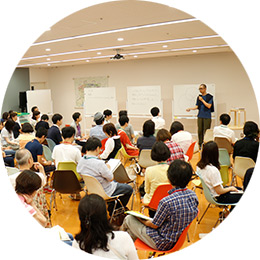

Tobira select courses to learn about one or more of the following themes, based upon scenes that could take place during the program: “Art Appreciation,” “Accessibility,” and “Architecture.” Visiting expert lecturers, museum curators and university faculty conduct these courses, which draw from hands-on training and evaluation meetings.
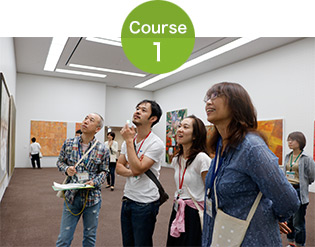
Art Appreciation
- Learn how to appreciate works of art with others through dialogue.
Learn about activities that enhance our art appreciation experience through dialogue. Discuss how to create an environment in which visitors may freely enjoy and interpret the art around them.
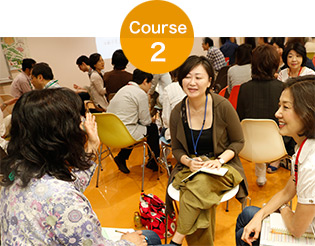
Accessibility
- Consider the accessibility of a particular museum and inclusive programs.
Think of an ideal museum environment where everyone can easily gather, regardless of the presence of any disabilities. Try to recognize possible situations and matters in search of making a museum where everyone can visit without hesitation.
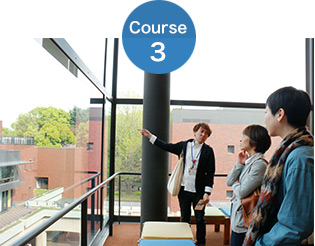
Architecture
- Consider the importance of each museum’s unique physical form.
Learn basic facts about the physical form of a museum to enhance the museum going experience. This is not limited to just historical facts and trivia about the Tokyo Metropolitan Art Museum, as participants also visit other museums in order to consider the charms of various types of architecture.

STEP 1 Start with “Everyone gather around”
STEP 2 Goes with Tobiras “Who are there.”
“Tobi-Labo” consists of meetings that the Tobira organize on their own initiative in order to discuss and adopt new projects. These cooperative efforts between people from such diverse backgrounds often cultivate unique activities that, in turn, widen the very possibilities of communication through art. Tobi-Labo also serves as a place to have relaxing, albeit enriching dialogue between Tobira, which fosters a new sense of value for the Ueno Park museums.
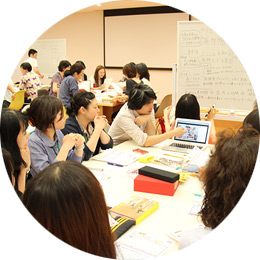
Tobi-Labo starts with
“Everyone gather around”.
If one of the Tobira have an idea that they would like to develop, that persons raises his or her hand and asks if others are interested. A project begins when more than three people join together to form a team.
Tobi-Labo goes with Tobiras “Who are there.”
When a team is formed, a Tobi-Labo is born. It is important to incorporate ideas from all participants. Listening to each other and discussing freely will generate new and rich ideas. Museum curators and university faculty help Tobira develop their unique activities.
Dismissed for the next activity!
The Tobi-Labo concludes upon achieving a project’s objective, and Tobira review their completed activities with program participants. When another new idea is born, somebody else raises a hand in order to form a new team for a new project. This cycle of forming and dissolving teams keeps relationships and communications fresh for the duration of the program.
At the “Down the Road Seminars,” the Tobira discuss how to remain engaged after leaving the Tobira Project, then put ideas into practice. Participants can design seminars that would be useful for themselves, such as study sessions with guest lecturers, workshops and so on. These seminars are where our art communicators complete their training.
After the end of their three-year term, the Tobira each return to their own communities. They continue to engage in diverse dialogue-oriented activities, capitalizing on the connections that they established over their term, and the skills they acquired through activities and seminars. The countless small seeds that are produced at the museum go onto sprout in society at large, bringing together people of diverse backgrounds and values.
Tobira Project has expanded its range of activities to include working collaboratively with Museum Start iUeno, an education-oriented program conducted between the nine museums and cultural facilities of Ueno Park, with Tokyo Metropolitan Art Museum and Tokyo University of the Arts at the project’s helm. This program primarily aims to enrich children’s first visits to museums, and fosters an environment in which children and adults can learn hand-in-hand. Tobira facilitate and support the execution of this program.
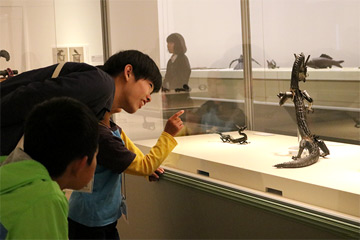
A learning collaboration between adults and children
At “iUeno,” the art communicators “Tobira” take in the children and support them in going through the museum activities worry free. Learning together with adults who aren’t your teachers or parents means a chance to encounter all kinds of values.
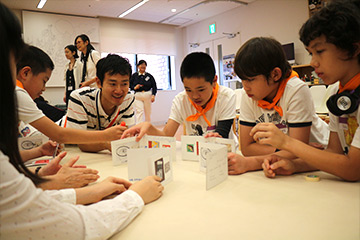
A museum experience for every child
Museums are invaluable sources of cultural assets that anyone can access. Aside from our programs for families and schools, we’ve set up lots of different entryways to a “museum debut,” such as our inclusive program for foster children or children in difficult economic circumstances. So that every child can go to the museum.